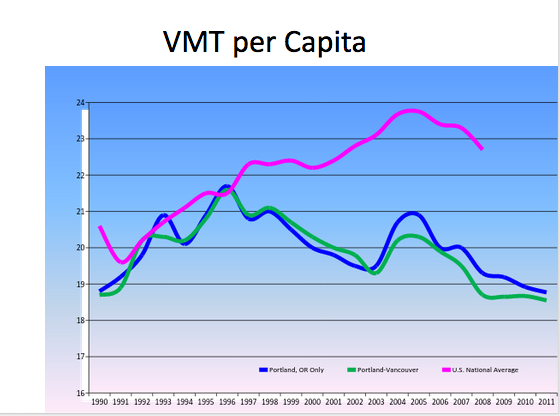Back in December, two T4America members in the Pacific Northwest (Portland Metro and the City of Portland) and other allies organized events to bring in Mark Fenton, a leader in clear thinking on transportation, health and walkable communities.
The Portland region was Mark’s first stop on a speaking tour of Oregon supported by the state Department of Land Conservation and Development. I attended both events, and I was most impressed by Mark’s persuasive arguments for charting the smartest course for making our communities the best places they can be, even if it cuts against the pervasive conventional thinking about moving cars.
SGA Local Leaders Council member Mayor Denny Doyle kicked off the morning event at the Beaverton Public Library by sharing the work this light rail suburb on the west side of the Portland metropolitan region has been doing to boost its downtown vibrancy and walkability.
Then Mark took the stage, and after having us close our eyes and recall our first memories of being physically active, led the audience through a few points of agreement:
- Generation Xers and Baby Boomers (the vast majority of those in attendance) grew up “free range” and experienced physical activity that way – with their friends and typically without adult supervision.
- Most kids do not have the same opportunities for free range physical activity today.
- Everyone in the audience agreed kids would benefit from being more free range today.
So, “What are you doing about it?” Mark asked.
He then put forward a compelling argument that right land uses, complete active transportation networks and welcoming community design are the key issues to to make walking, biking and transit safe, convenient and intrinsic to daily life. Doing so can act as a foundational component of getting people physically active again so that we can address the public health crisis and escalating costs to taxpayers — America spends 30 percent of its GDP on health costs.
Along the way Mark invited participants to air concerns and addressed them.
- Stranger danger is the same today as it was in the 1970’s.
- Legal pressures against free-range parenting are overblown. In Bethesda, Maryland, where two kids were scooped up by the police for being a half-mile from home, the city has since adopted a resolution supporting free-range parenting.
- Cultural norms around active transportation aren’t going to shift if the infrastructure doesn’t change. Cultural norms around tobacco use shifted because public policy compelled changes in bars, restaurants, planes, and workplaces.
Mark also met with community leaders and city staff in East Portland’s Jade District, where T4A has been working with Asian Pacific American Network of Oregon (APANO) on creative placemaking around the proposed Powell Division bus rapid transit line.
The proposed BRT improvements have raised local hopes of improved transportation in their neighborhoods, but also heightened fear of displacement as property values and rent costs increase when the neighborhood becomes more desirable. This conflict can lead disadvantaged communities to resist necessary improvements they would otherwise want because they’re scared that if the neighborhood becomes too desirable, they’ll be priced out.
Mark’s take: gentrification is already happening, so arguing for the “B-version” won’t prevent displacement, but will certainly result in a neighborhood that is less than it could be. Instead, Mark argued, leaders should push for both: the best anti-displacement strategies and the best possible project. (Something that a creative placemaking approach can help achieve.)
I’ll be watching to see how these ideas resonate and impact the conversation amongst members and allies in the Portland region.





